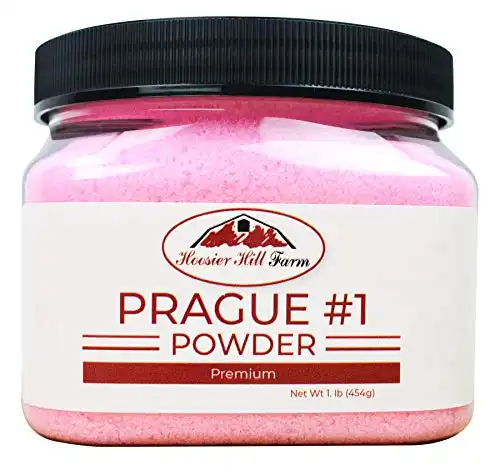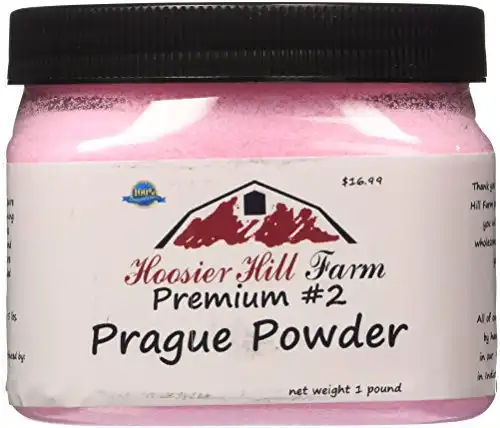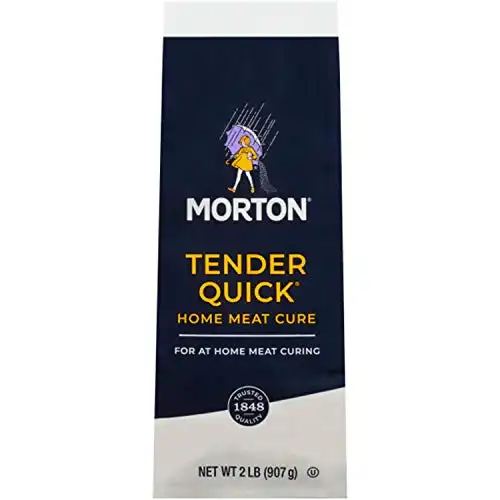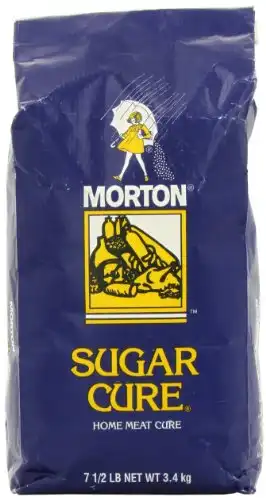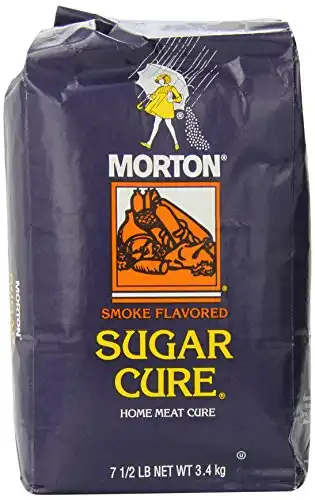Ultimate Guide to Curing Salts

Curing salts may seem like a very specialized subject. But once you get a taste for smoking, then curing your own bacon or prosciutto is a natural progression. The ability to make your own delicious pastrami, country style ham or corned beef from scratch is definitely a “next level” skill.
Curing is also an important part of safely cold smoking.
There is some know-how required when using curing salts, and getting it wrong can have serious consequences. Let’s not pull any punches here, curing gone wrong can be fatal.
Getting it right, however, is not complicated. In this guide you’ll learn how curing works, what products to use, and how to keep everything safe.
The history of curing meats

If you only care about how to use curing salts feel free to skip ahead. But we think this history is pretty interesting.
Curing meat is a technique steeped in history. We don’t know when exactly our ancestors realised that dousing meat in certain salts preserved. For all we know it could have been a happy accident!
However it happened, this discovery was of great benefit to those living in a time when there was no refrigeration, and no local butcher’s shop.
When a large beast was butchered, curing the meat offered a solution for preserving it, should fresh meat not be readily available at a later time.The Ancient Egyptians, Chinese and Romans all used this technique to preserve their meat.
Around the middle ages, Saltpeter was discovered. Found in rocky outcrops, Saltpeter is now more commonly known by its chemical name potassium nitrate.
When applied to meat, the Saltpeter not only preserves the meat, as earlier forms of curing salts did, but it also maintains an appealing pink color.
While people often refer to curing salts as pink salt, you shouldn’t confuse it with Himalayan pink salt, which is pure salt with trace elements that give it it’s pink color.
Around the beginning of the 20th century, the connection between the use of these salts and the suppression of food borne illnesses such a botulism was discovered by German scientists.
Finally In the 1920’s curing salts started to be sold commercially.
Sadly, while the curing process was being honed, some unfortunate individuals lost their lives, especially when the processes at play were not fully understood and the curing method was not executed properly.
Indeed, curing meat was of great use throughout history due to its practicality. But the method has continued down to this day because, practicality aside, cured meats are just plain tasty.
What is in Curing Salts?
These days, curing salts are a blend of salt, sodium nitrite & sodium nitrate. Here is a basic breakdown of these ingredients:
- Salt (NaCl) – Commonly known as table salt.
- Sodium nitrite (NaNO2) – Sodium nitrite is the ingredient that is responsible for most aspects of the curing process. Bacteria in the meat also convert sodium nitrate into sodium nitrite.
- Sodium nitrate (NaNO3) – Included in salt cure mixes for longer cures. The inclusion of sodium nitrate allows for the continued breakdown of sodium nitrate into sodium nitrite as the cure progresses over a longer period.
If you want to know more about the different types of curing salt this video has a nice explanation of the difference between sodium nitrite, nitrate & pink curing salt.
Curing Salts – What are the Dangers?
Before we address the elephant in the room, (by that I mean the often quoted, “nitrates cause cancer” line) let’s address a more immediate concern. Nitrates and nitrites are toxic when not used in the recommended quantities.
The amount of table salt you would use in a standard recipe, for example, could actually be a lethal dose of curing salts. To avoid confusion with table salt, curing salts are often tinted pink.
Store your curing salts out of the reach of children, and carefully follow the guidelines as to how much to use.
Also, don’t confuse widely available pink Himalayan salt with curing salts.
Curing salts and risk of cancer
As soon as you start talking about curing salts it doesn’t take long for someone to mention the risk of cancer. This has been a widely held view since the 1970’s when a report came out indicating that this was the case.
Since then, there have been more studies on the topic. As always, there are varying results. Interestingly, many studies indicate that the link between nitrates/nitrites and cancer is not as strong as was initially thought.
This is great news for those of us who like to cure our own meat and don’t want to die of cancer!
In fact, one study, published in 2015, indicates that intake of nitrates could actually reduce the risk of gastric cancer. The same study does state, however, that there could be a link between high consumption of nitrites and gastric cancer. The study also concludes that more research is needed on the topic to provide conclusive findings.
Another interesting point to consider is that cured meat is not our primary dietary source of nitrites. According to the American Meat Institute:
“Less than five percent of daily nitrite intake comes from cured meats. Nearly 93 percent of nitrite comes from leafy vegetables, tubers and our own saliva.”
The FDA has stated that processed meats are safe to consume. However, they do state that these products are best eaten in moderation. The World Cancer Research Fund, for instance, recommends that the equivalent of about five 3 ounce servings of cooked red or processed meat a week is safe (3 ounces is equivalent in size to a deck of cards).
In 2016, WHO classified red and processed meats as carcinogens. While this made headlines across the globe, the findings were not quite so sensational on closer inspection. WHO states:
“Eating meat has known health benefits. Many national health recommendations advise people to limit intake of processed meat and red meat, which are linked to increased risks of death from heart disease, diabetes, and other illnesses.”
Clearly, this is not an open and shut case.
One thing is for certain, your risk of death from botulism is a real and present danger if you attempt to cure meat without using nitrates and nitrites.
So long as you follow the recommended guidelines you should be safe.
Commercially Available Curing Salts, and When to Use Them
You can buy curing salts already mixed in the correct proportions, that are safe for use as long as you follow the instructions. Some examples are:
Prague Powder #1
This curing salt is also known as Insta Cure #1, Pink curing salt #1, sel rose, quick cure, tinted curing mixture (TCM), Modern cure, DC cure, or DQ cure.
Prague Powder #1 is for short term cures, and can be used in the preserving and curing of semi-dry and cooked meats, such as sausage, fish, jerky, bacon, ham, pastrami, hard salami, corned beef.
Points to remember:
- Use amounts as outlined by the manufacturer.
- You may be surprised at how little you need to use, so purchasing a jar of this product will likely last a very long time.
- Prague Powder #1 and #2 are not interchangeable.They are specifically formulated products for different curing techniques.
Prague Powder #2
This product is also known as Pink curing salt #2, Insta Cure #2, Slow Cure.
Prague Powder #2 is used for cures that span over weeks or months. Use this type of curing salt for meats you plan to dry cure, for example hams, salami, pepperoni and prosciutto.
This product contains both sodium nitrate and sodium nitrite. The inclusion of sodium nitrate is what enables this curing salt to act over the longer term as the nitrate becomes nitrite as it is processed by bacteria naturally present in the meat.
Points to remember:
- This type of curing salt is not available in Canada.
As with Prague Powder #1, use this product strictly according to manufacturer guidelines.
Morton® Tender Quick®
This curing salt is less concentrated than other brands. It is for use in fast cures. You can use Tender Quick on meats, game, poultry, and fish. Tender Quick can also be used as a dry cure or a pickling cure.
Points to remember:
- This product is not pink like other curing salts, so be sure to store and label it carefully.
The Morton® products mentioned in this guide cannot be shipped outside the US by Amazon.
Morton® Sugar Cure® (Plain)
This curing salt is similar Tender Quick, however, some of the salt is replaced by sugar. It is primarily used for dry curing hams and bacon but this product can also be used for dry or sweet pickle curing of meat, poultry, game, salmon, shad, and sablefish.
Points to remember:
- There are some complaints that this product arrives hard, especially when ordered online. It appears that the packaging may not keep the product adequately dry, and the sugar hardens if exposed to moisture. It might be worth checking if you have a local supplier if you want to avoid this issue.
Morton® Sugar Cure® (Smoke Flavor)
Sugar Cure Smoke Flavor is formulated especially for dry curing large cuts of meat like hams and bacon, this product will take longer to cure the meat than Sugar Cure Plain. This product also contains hickory smoke flavoring, spices and dextrose.
Points to remember:
- This product is for dry cures only. Do not use it to make a brine.
How to Use Curing Salts – Safely!
Now that we have dug into the history, addressed the controversy, and established the benefits of using curing salts, let’s discuss how to use them.
Before we dive in, there are a few general principles that need to be kept in mind.
- If you would like a reliable resource to calculate how much nitrate you need to use and how long to leave your meat to cure, refer to this nitrate calculator
- Curing is a meticulous process. The manufacturer’s recommended quantities must be followed exactly. Curing is probably the only area of barbecuing where experimenting is definitely a no go.
- You will need to keep all equipment and surfaces clean, and clearly label all products and cuts of meat. Make a note of special instructions for each piece of meat, and note the dates that each piece will need further attention. It is a good idea to note these dates on your calendar, in a diary or on your phone. This is a process where you cannot take chances or leave things to memory.
- Keep your meat at temperatures between 36°F and 40°F unless you are air drying.
- If you would like to avoid your meat having an excessively salty flavour, soak the cured meat in cold water and then air dry it before smoking or barbecuing.
- “If in doubt, throw it out”. This is a lot easier said than done when time, money and a level of pride has been invested in your cure. But if anything about your meat makes you unsure as to its safety, whether it be appearance, smell, or a hiccup in the process itself, the stakes are too high to cross your fingers and hope it will be OK.
- Don’t reuse your curing solution.
Common curing methods
There are 3 common curing methods. Let’s have a look at each method, along with the advantages and disadvantages of each.
Injecting
In this method the curing salt is made into a solution. The meat is then injected with the curing solution. In a commercial setting, this is achieved using many fine needles. Often, cheaper hams, bacon and corned beef are cured using this method.
Advantages: This method can speed up the curing process.
Disadvantages: For someone using this method at home without commercial scale equipment, an even spread of curing solution may be hard to achieve. The result is pockets of meat with either lots of curing solution, or none at all.
Another issue is that this method can leave your meat a little flavorless, plumped up and watery.
Dry Curing
A large slab of meat hanging in a deli or a cellar is probably the first image that springs to mind when you think of cured meats. While dry curing is one of the most traditional methods of curing meat, it is also one of the most complex.

Before you start dry curing anything, you need to weigh it. It is only safe to consume dry cured meat after it has lost 35% of its initial weight. You can wait for it to have lost more of its original weight, but this is more a matter of personal preference in terms of the texture of the end product.
The spice mix and curing salt is mixed together first, and then applied to the meat or fish. The meat is then stored in a temperature and humidity controlled space.
The ideal temperature is between 50°-60°F, and the humidity needs to be between 65% and 80%. You will need to consider whether you have an appropriate place that you can dedicate to this process, as the meat will need weeks, even months, to cure.
The area you dry cure your meat will also need to be free of rodents, insects and pets.
Advantages: Of all the curing methods, dry curing can produce the most complex flavors due to the different molds and bacteria that form on the meat. The process itself can be a real passion for some.
Disadvantages: This is a very involved process, and requires a lot of dedication and some serious know-how. The margin for error is quite high. Therefore, dry curing may be better left to professionals or at least those with a lot of experience.
Equipment required:
You will need to have specialized equipment, such as a temperature and humidity sensor to monitor the temperature and humidity of the place you are curing your meat.
If you don’t have an appropriate area in your house, you can create a suitable curing area using an old fridge, a temperature controller to control the temperature inside the fridge, and a hygrostat and humidifier to keep the humidity in check. You can find a detailed article about how to set up this kind of curing area at mattikaarts.com.
It is completely up to you how much of a set up you want to invest in, but it is worth considering that if you fail to control the humidity and the temperature, then undesirable mold and bacteria will grow.
Dealing with problems
If mold and bacteria does grow on your meat, it is vital that you have a solid understanding of these organisms and can positively identify them. Some of the molds and bacteria are dangerous, while others are not. You will need equipment such as a microscope and analytical tools to identify what exactly is growing in and on your meat. Sometimes, a trip to your local lab might even be in order.
If you are dry curing your meat in the fridge, you will need to turn it once a day.
You will also need to watch for any liquids that accumulate on the meat as it cures. This is a result of the salt drawing moisture out of the protein in the meat. This fluid should be drained off.
If you are curing multiple meats at one time, divide them into batches, and re-salt them every three days or so. This is a process known as “overhauling”.
Something to watch out for is “case hardening”, wherein the outside of your meat dries out too quickly due to low humidity or high airflow, preventing the inside of your meat from drying out properly.
Wet curing or Brining
This is the process of fully submerging the meat into a chilled solution of salt cure and flavors.
You will need to use containers or bags that are not going to react with the salt cure solution. Also remember that if you are going to be leaving your meat in the solution for more than 7 days, the solution should be replaced. You will also need to stir the solution occasionally to ensure that the salts in the solution are dispersed evenly.
If you are having trouble keeping the meat fully submerged, you can weigh it down with a dinner plate or something similar.
Advantages: This process takes a lot less time than dry curing. It also achieves a more even spread of curing solution throughout your meat than injecting.
Humidity is easier to control while wet curing, and the lack of oxygen in the process means nasty bacteria don’t get the chance to grow.
Disadvantages: This method is generally only practical for smaller cuts of meat. Otherwise sourcing a tub big enough might prove a challenge!
Curing Salt Substitutes
Perhaps you have heard of curing substitutes which are free of nitrates and associated cancer concerns. Are they effective? Not according to Meathead Goldwyn

Meathead Goldwyn, The Science Of Curing Meats Safely
“People often ask if they can cure meats without nitrites and just increase the salt. Salt inhibits bot’s growth, but won’t kill it. Neither will vinegar.
You should not attempt to cure meat at home without a curing salt.”
There are some “natural” or “no nitrite” cured meats on the market, but if you look closely at the label, they often have some sort of extract of celery in them because it contains nitrate which can convert to nitrite.
There are recipes for “curing” that don’t use nitrites, so technically they are not really cures, and they cannot kill bot so they must never be submerged in wet cures. I consider them risky.
There are products commercially available that are touted as nitrite free. It is worth noting that they are processed using celery or beetroot juice. These juices contain nitrates, which turn into nitrites, meaning you are still ingesting nitrites when you eat these products.
You also need to be careful using celery powder as a nitrate/nitrite alternative. The amount of nitrate in these powders is variable, meaning you could, rather ironically, end up ingesting far more nitrites than you need to.
The reality is, nitrite free “cures” cannot kill botulism and are not safe to use. You can be assured that professional cures contain the correct ingredients, and when the instructions are followed, your meat will be safe to consume.
Wrapping it up
It is hard to deny the allure of the smell of bacon frying, or the sight of a platter adorned with beautifully cured prosciutto. While there is some know how needed to execute a expertly cured meat, the payoff is well worth it.
Do you cure your own meats? Or are you planning on giving it a try? Share your thoughts in the comments below. If you enjoyed this article and found it helpful, please share!


